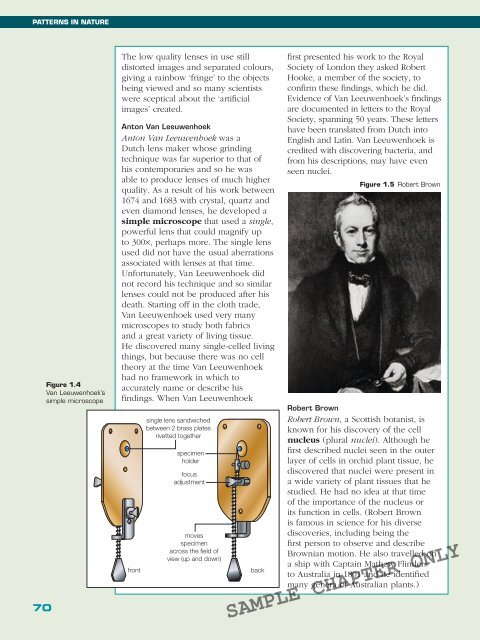BIOLOGY IN FOCUS
BIOLOGY IN FOCUS
BIOLOGY IN FOCUS
Create successful ePaper yourself
Turn your PDF publications into a flip-book with our unique Google optimized e-Paper software.
PATTERNS <strong>IN</strong> NATURE<br />
70<br />
Figure 1.4<br />
Van Leeuwenhoek’s<br />
simple microscope<br />
The low quality lenses in use still<br />
distorted images and separated colours,<br />
giving a rainbow ‘fringe’ to the objects<br />
being viewed and so many scientists<br />
were sceptical about the ‘artificial<br />
images’ created.<br />
Anton Van Leeuwenhoek<br />
Anton Van Leeuwenhoek was a<br />
Dutch lens maker whose grinding<br />
technique was far superior to that of<br />
his contemporaries and so he was<br />
able to produce lenses of much higher<br />
quality. As a result of his work between<br />
1674 and 1683 with crystal, quartz and<br />
even diamond lenses, he developed a<br />
simple microscope that used a single,<br />
powerful lens that could magnify up<br />
to 300×, perhaps more. The single lens<br />
used did not have the usual aberrations<br />
associated with lenses at that time.<br />
Unfortunately, Van Leeuwenhoek did<br />
not record his technique and so similar<br />
lenses could not be produced after his<br />
death. Starting off in the cloth trade,<br />
Van Leeuwenhoek used very many<br />
microscopes to study both fabrics<br />
and a great variety of living tissue.<br />
He discovered many single-celled living<br />
things, but because there was no cell<br />
theory at the time Van Leeuwenhoek<br />
had no framework in which to<br />
accurately name or describe his<br />
findings. When Van Leeuwenhoek<br />
front<br />
single lens sandwiched<br />
between 2 brass plates<br />
rivetted together<br />
specimen<br />
holder<br />
focus<br />
adjustment<br />
moves<br />
specimen<br />
across the field of<br />
view (up and down)<br />
back<br />
first presented his work to the Royal<br />
Society of London they asked Robert<br />
Hooke, a member of the society, to<br />
confirm these findings, which he did.<br />
Evidence of Van Leeuwenhoek’s findings<br />
are documented in letters to the Royal<br />
Society, spanning 50 years. These letters<br />
have been translated from Dutch into<br />
English and Latin. Van Leeuwenhoek is<br />
credited with discovering bacteria, and<br />
from his descriptions, may have even<br />
seen nuclei.<br />
Figure 1.5 Robert Brown<br />
Robert Brown<br />
Robert Brown, a Scottish botanist, is<br />
known for his discovery of the cell<br />
nucleus (plural nuclei). Although he<br />
first described nuclei seen in the outer<br />
layer of cells in orchid plant tissue, he<br />
discovered that nuclei were present in<br />
a wide variety of plant tissues that he<br />
studied. He had no idea at that time<br />
of the importance of the nucleus or<br />
its function in cells. (Robert Brown<br />
is famous in science for his diverse<br />
discoveries, including being the<br />
first person to observe and describe<br />
Brownian motion. He also travelled on<br />
a ship with Captain Mathew Flinders<br />
to Australia in 1801 and he identified<br />
many genera of Australian plants.)<br />
SAMPLE CHAPTER ONLY
















